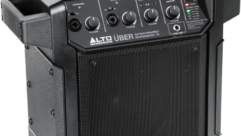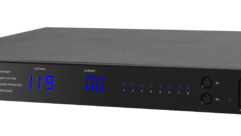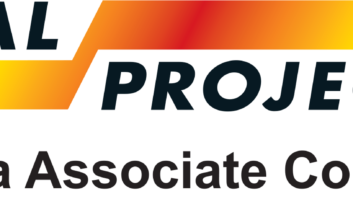Contrary to what the electric companies would have you believe, all voltage is not created (or distributed) equally. One hundred twenty volts is more wishful thinking than reality most of the time. Yet most electronic equipment for use in North America is designed to operate at 120V, alternating 60 times per second. Go too far outside of that range and you encounter problems, especially with digital equipment, which must operate in a highly regulated environment.
If that weren’t enough cause for concern (and problems with your install), there is also the possibility (probability?) that the electric lines you have access to for your install are probably being shared by other devices such as air conditioners/heaters, refrigerators, and any number of other devices that will create frequent fluctuations and surges in your AC power. Any of those devices can also introduce noise into the power lines. Power conditioners do help to filter out the unwanted noise, and even though the incoming power line is not the most common source of noise interference, the protection is still good to have and can save you many a headache.
Power surges, voltage spikes, and electromagnetic noise can all cause potential problems with electronic equipment. There are many products available to address each area of concern, but one product group addresses all three problems. These nifty black boxes are called power conditioners or line conditioners. The correct term is power line conditioner, but however you say it, in order to be considered a power conditioner in the generally accepted sense of the term, the unit must incorporate surge protection, electromagnetic-interference/radio-frequencyinterference (EMI/RFI) noise filtering, and voltage regulation. For most professional installations, it was felt that these devices should also be rackmountable. These were the key criteria used to define this technology spotlight.
VOLTAGE REGULATION
At the top of the list is the line-leveling function, or voltage regulation. The professional audio, video, and lighting equipment people use is usually designed to operate on 115V (or so) of AC power. Most equipment can tolerate a fairly broad variance of line voltage, but every product has its limits. When those limits are exceeded, damage can occur. The voltage regulation function of a power conditioner establishes high- and low-voltage limits that are usually within the safe operating range of the equipment it is protecting, though today’s digital gear tends to have tighter tolerances.
If you’re installing equipment in a building that shares its main power line with other buildings or high-current draw devices like air conditioners, microwave ovens, and coffee machines, the fluctuations in the voltage are likely to exceed the tolerance of your equipment at some point.
Ideally, the output of a power supply should be at a constant voltage. Unfortunately, this is difficult to achieve. Two factors can cause the output voltage to change. As previously mentioned, the AC line voltage is not constant. The 115V reference level is just that: a reference. AC power can actually vary from about 105 VAC to 125 VAC under normal conditions. The AC line voltage alone can be responsible for as much as a 20 percent change in the DC output voltage of a power supply. A change in the load resistance can also affect the DC output voltage. In complex electronic equipment, the load can change as circuits are switched in and out. In a video monitor, for example, the load on a particular power supply depends on the brightness of the screen, the control settings, and many other factors. Some voltage regulators have the ability to maintain a steady voltage by stepping up or stepping down the voltage. Stepping down is not a problem, but when you step voltage up, you do so by lowering the available current (or amperage). That is not always wise in a situation in which your equipment requires large amounts of current. For example, if you were running a conventional power amplifier at high volume and there was a sudden drop in the voltage right when the amp was required to produce a particularly loud or low frequency, your voltage regulator would raise the voltage, but the amp could no longer draw the current it needed to produce that note. That could cause a circuit breaker to trip, shutting down the whole rack of equipment.
Because most power supplies have a fixed internal resistance, they cannot absorb large fluctuations in AC voltage. As the load resistance decreases, the internal resistance of the power supply decreases the voltage across the load. Whereas that has the potential to damage any electronic equipment, digital devices are especially susceptible to fluctuations in DC voltage.
In general, circuits are designed to operate with a particular supply voltage. When the supply voltage changes, the operation of the circuit may be adversely affected. Consequently, some types of equipment must have power supplies that produce the same output voltage regardless of changes in the load resistance or changes in the AC line voltage. That is where the voltage regulation function of a power conditioner comes into play. By constantly monitoring the AC voltage level and limiting it when necessary, a more consistent voltage level is maintained, lessening the chances of damage to or erratic behavior of your equipment.
SURGE SUPPRESSION
The next and possibly most critical function of a power conditioner is surge protection. In addition to the constant variations on line voltage, there are many events and conditions that can cause surges, or spikes, in the AC power line that can damage transistors, make logic chips to behave erratically, and even cause transformers to explode under extreme circumstances.
Voltage spikes and surges are the silent equipment killers. What makes these events particularly nasty is that you never know when they are going to occur, they happen so quickly that there is rarely any trace evidence (other than the damaged equipment), and a voltage spike may damage one component or all of them. It might occur several times before inflicting any damage, or it could cause total product failure the first time it occurs. Its ability to invade an electronic component and take out just one resistor or change the value of just one capacitor makes it more than just dangerous. It can leave you scratching your head as to exactly why your equipment is behaving abnormally. And head scratching in front of clients is generally frowned upon and to be avoided whenever possible.
(For a more in-depth explanation of surge protection, see “Shelter from the Storm” on p. 38.”)
EMI/RFI FILTERING
EMI/RFI noise filtration isn’t really a critical factor in preventing equipment failure, but it is an important step in helping to insure that the best sound and picture quality are delivered on a consistent basis.
EMI and RFI are terms that are often used interchangeably, though they are not the same thing. EMI is a specific type of noise that can be introduced into a power line, whereas RFI represents the frequency range (or pitch) of noise that can be introduced into a power line. They often go hand in hand, but not always. Both can cause noise problems, especially in installations in which power lines are run close to or touch audio/video signal cables. Power lines can also act as antennas for picking up noise and transmitting it directly into the electronic circuitry, where it can do anything from producing an audible buzz to causing equipment to malfunction.
Although there are many ways that EMI/RFI noise can be introduced into an audio or video signal path, the first line of defense is to eliminate any noise from the incoming power lines. It is ironic that the equipment you are trying to protect from unwanted noise is often the worst culprit in producing it.
In the case of power conditioners, filtering out the noise is usually accomplished with a series of passive resistors and capacitors applied to the power lines to create bandpass filters in much the same way that they are applied to a speaker system crossover to block high and low frequencies.
THE PRODUCTS
There are many manufacturers of high-quality products that accomplish one or two of the functions described in this article, but in the interest of minimizing confusion, the focus is limited to products that meet all three criteria in a rackmountable housing.
MANUFACTURERS
Applied Research and Technology (ART). ART recently unveiled its 400 Series Digital Power Distribution Systems, models 401, 402, and 403. All offer surge/spike protection, EMI/RFI filtering, frontmount circuit breaker, 1,800W capacity, and eight rear AC outlets. The 402 and 403 units add AC line-voltage metering and pull-out rack lights with dimmer; the top-end 403 includes a load current ammeter.
ETA Systems. ETA Systems offers a broad range of models, each with a slightly different feature set tailored to specific applications, but all are built on the same foundation. The ETA models have a convenient, easy-to-understand nomenclature structure. The PD in the products’ names stands for power distribution. The numeric portion identifies how many AC outlets the unit contains. The L means the unit has pull-out rack lights. It’s important to note that the lights used in the ETA boxes are 110V “Christmas tree” lights, which can be purchased virtually anywhere. They also do not have a variable dimmer — just a high/low switch. The reason for that is to minimize the possibility of introducing noise into the system. An improperly shielded dimmer or DC converter can create noise. The V signifies an LED volt meter that is accurate to within ¼ of a volt. One S means it uses sequential step-up or -down transformers and surge protectors. The SS models also use the sequential technology and are standalone units that are not able to daisy-chain with other conditioners. The P identifies the pro series, which has the beefier 20-amp capacity.
Furman Sound. Furman also has a broad range of products that are divided into the 15-amp and 20-amp categories. Both lines feature a frontmounted circuit-breaker switch, but the 20-amp version is rated for use as a master switch, which is convenient for use in buildings where fire and safety codes aren’t always followed to the letter and where you might find yourself tapped into a power line that’s on a 50-amp breaker somewhere in a dungeon. To put this into perspective, 50 amps of current on a 115V line would equal approximately 6,000W of power, which translates into the potential to do a great deal of damage.
The Furman models use MOVs and gas-discharge tubes to control voltage spikes. This combination allows the larger units to absorb as much as 11,000 amps, which is not uncommon in the event of a lightening strike. All of the Furman units also have the high-voltage shutdown protection common to power conditioners. Front-panel LEDs show line voltage and protection status.
Panamax. Panamax makes several products focusing on surge protection and noise filtration. Its MAX 5500 and 5510 incorporate a dual-filtration system. Four of the unit’s ten AC outlets deliver power through a large isolation transformer, providing ultraclean power for digital equipment, such as CD/DVD players and hard-drive video players. Another four outlets are filtered through balanced “double L” circuits to remove unwanted noise.
Two of the power outlets have a “delayed-on” feature to accommodate large current-draw equipment such as power amplifiers or powered subwoofers. Both units also provide surge protection for coaxial cables and a telephone line. Voltage regulation is accomplished through a high and low current limiting filter. If the incoming voltage exceeds or falls below the set parameters, a protection circuit kicks in to protect the gear. They use a combination of analog meters and LEDs for status display and come with a detachable convenience lamp that has a handy dimmer control.
SurgeX. SurgeX takes a distinct approach to surge protection (see the sidebar “The Nondiversionary Alternative”). Whereas most surge protectors shunt the surges to the ground path, SurgeX models actually store the excess electricity and then slowly discharge it across line and neutral, which avoids contamination of the equipment ground conductor. That is especially useful for protecting digital equipment, because logic chips are particularly sensitive to negative power spikes and unstable equipment ground.
SurgeX conditioners use three circuits for surge/spike protection: a series reactor current limiter, a dual-polarity voltage limiter, and dual pulse inverters. They also utilize an impedance tolerant noise filter. Future models may also incorporate a proprietary approach to voltage regulation.
Tripp-Lite. Tripp-Lite has one entry in the power conditioning product group, but it has some distinct features. It employs transformer-based voltage regulation to keep the voltage at a true 120V, even if the incoming voltage drops as low as 87V. Of course, that is accomplished at the expense of amperage, but in applications in which steady voltage is more critical than high-capacity current draw (read: computers and telephone systems), this is a valuable feature. This unit is beefy, too. It delivers as much as 20 amps of current without breaking a sweat. Seven LEDs on the front panel register incoming voltage levels. The unit has a total of 14 AC outlets: 12 on the back and 2 up front.
SUMMARY
As more and more of the equipment people use is digitally based, the need for clean power will continue to increase. Regardless of the gear you specify into an install, some type of power protection is always a good idea. Power conditioners provide a nice combination of protection against so-called “dirty” power and noise in the building’s power source.
Chris Steinwand is a marketing veteran of the pro audio/video industry, a freelance writer, and the director of Stonejam Consulting. You can reach him through e-mail at [email protected].
The Nondiversionary Alternative
Nondiversionary surge suppressors act as lowpass filters, which simply block the high-frequency components of power line surges. The first line of defense is the massive surge reactor, which is in series with the hot wire. (The weight of the surge reactor is the reason these products weigh much more than other surge protectors.) The surge reactor filters out small transients, slows larger surges, and limits the surge current. All current that passes to equipment connected to the unit passes through this filter. The remaining low-frequency surge energy is diverted into a bank of capacitors, which tracks, clamps, and contains the surge energy after it has been slowed by the surge reactor. It is then stored for the duration of the event and is then slowly discharged back across the incoming hot and neutral conductors without involving any connection to equipment ground. This type of surge suppressor can thus be placed anywhere along a power circuit without the ground reference elevation disadvantage of shunt-mode surge protection devices. In this way, the safety ground is never contaminated and interconnected equipment is not put at risk when a surge comes in on the power lines feeding the equipment. Pipersville, Pennsylvania — manufacturer SurgeX’s nondiversionary surge suppressors incorporate floating clamping voltage circuitry, which will withstand considerable overvoltage conditions of indefinite duration without damage or degradation of performance and are UL certified to a surge endurance specification of A-1-1, the highest possible rating available (the UL A-1-1 surge endurance testing procedure involves the application of a minimum of 1,000 surges of 6,000V at 3,000 amperes [the highest surge voltages and currents likely to be encountered in a typical building], as specified in IEEE/ANSI C62.41-1991). Most importantly, these surge suppressors do not incorporate sacrificial components of any kind, effectively guaranteeing an unlimited service life without the requirement for testing or periodic maintenance.
Comparing Power Line Conditioners
For More Information
Applied Research and Technology
www.artproaudio.com
Ž 201
ETA Systems
www.etasys.com
Ž 202
Furman Sound
www.furmansound.com
Ž 203
Panamax
www.panamax.com
Ž 204
SurgeX
www.surgex.com
Ž205
Tripp-Lite
www.tripplite.com
Ž 206
Ž Circle this number on Reader Service Card or visit
freeproductinfo.net/svc










